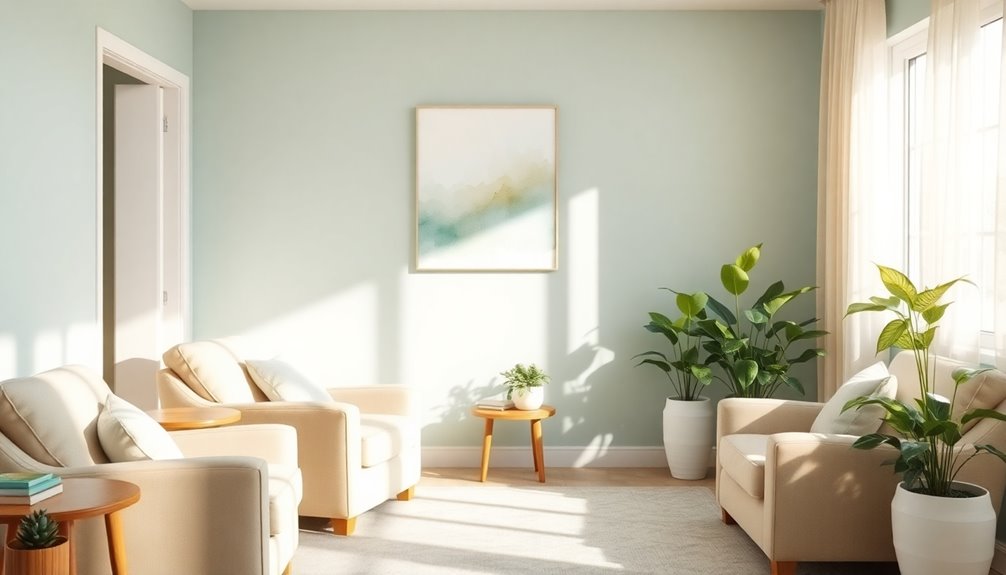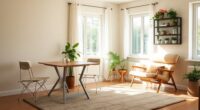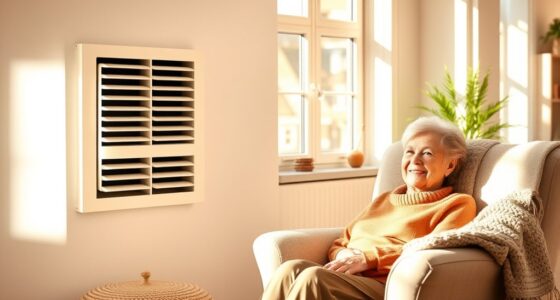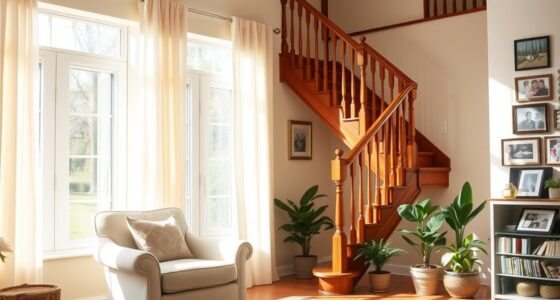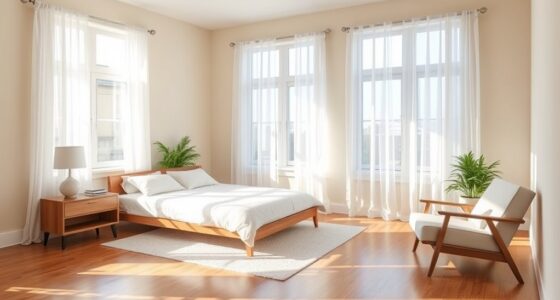To enhance calm and serenity in senior living spaces, focus on soft blues, greens, and warm beiges. These colors evoke relaxation and comfort, creating soothing environments. Incorporating nature-inspired hues can foster emotional well-being, while lighter shades increase spatial perception and warmth. Ensuring cohesion across areas with accent colors can stimulate social interaction without overwhelming residents. If you're curious about practical applications and additional color considerations, there's plenty more to explore on this topic.
Key Takeaways
- Soft blues and greens create a calming atmosphere, ideal for bedrooms and lounges, promoting relaxation among residents.
- Nature-inspired hues, like muted greens and warm beiges, foster emotional well-being and comfort in senior living spaces.
- Lighter colors, such as pale lavenders and soft grays, enhance spatial perception and contribute to a serene environment.
- Incorporating earth tones provides stability and security, helping anxious residents feel more at ease in their surroundings.
- Tailored color palettes that reflect individual preferences promote a sense of identity and belonging, enhancing emotional comfort.
The Psychological Impact of Paint Colors on Seniors

When you consider the impact of paint colors on seniors, it's clear that your choices can shape their emotional well-being.
The psychological impact of color is profound; warm colors like reds and yellows can energize dining areas, enhancing seniors' appetites. In contrast, cool colors such as blues and greens promote relaxation, making them perfect for bedrooms and lounges where restfulness is essential.
Soft yellows can evoke feelings of happiness in common areas, boosting mood and well-being. Additionally, nature-inspired colors create a serene atmosphere, fostering comfort for urban seniors.
Lighter colors not only enhance feelings of calm but also make spaces feel larger and more inviting, thereby greatly influencing residents' emotions and behaviors in their living environments.
The Role of Color in Senior Living Environments

Color plays an essential role in shaping the mood and emotional well-being of seniors in living spaces. By choosing the right hues, you can enhance navigation and wayfinding, making it easier for residents to move independently.
Additionally, seasonal color considerations can add warmth and variety, helping to create a more inviting environment year-round.
Mood and Emotional Impact
Choosing the right colors for senior living environments plays an essential role in shaping the emotional landscape of these spaces.
Colors can greatly influence mood, with cool shades like blues and greens creating an atmosphere of serenity and relaxation, perfect for bedrooms and lounges. Softer tones, such as pale blue or lavender, effectively reduce anxiety, especially for residents with cognitive impairments.
Conversely, warm colors like soft yellows foster feelings of optimism, making communal areas more inviting and encouraging social interactions. Earth tones, including browns and beiges, provide comfort and stability, helping anxious residents feel secure.
Navigation and Wayfinding Benefits
Effective navigation in senior living environments relies heavily on the strategic use of color to create a sense of orientation.
Thoughtfully chosen color schemes can greatly enhance residents' ability to navigate their surroundings. Here are three key benefits:
- Distinct Areas: Using different hues helps differentiate between spaces, boosting confidence and independence.
- Cognitive Support: Soft yellows and light blues provide a calming atmosphere for residents with cognitive impairments, reducing confusion.
- Enhanced Visibility: Contrasting colors for doorways and hallways improve safety, making paths and hazards more recognizable.
These color strategies not only aid navigation but also positively influence emotional responses and cognitive function, ensuring a safer, more comfortable living environment for seniors.
Seasonal Color Considerations
As the seasons change, so do the emotional and physical needs of senior residents in living environments.
Seasonal color reflections play a crucial role in creating spaces that nurture their well-being. During spring and summer, soft blues and greens can promote relaxation and calmness.
As the colder months approach, warmer colors like soft yellows and muted reds can uplift spirits and counter feelings of isolation. Nature-inspired palettes that reflect the seasonal landscape can further enhance emotional well-being.
It's important to evaluate physiological changes, such as lens yellowing, which makes softer tones more comforting. Additionally, fostering emotional alignment can significantly contribute to enhancing the overall atmosphere in senior living spaces.
Selecting the Right Paint Colors for Relaxation
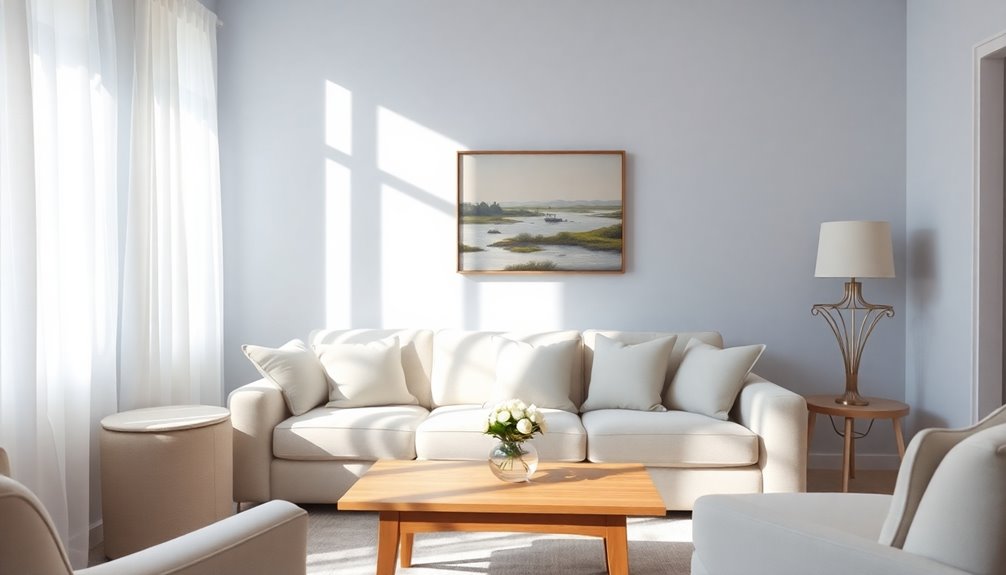
Selecting the right paint colors for relaxation can transform senior living spaces into serene retreats. To create a calming environment, consider these three options:
- Soft Blues and Greens: These colors evoke calmness and foster a connection to nature, making them perfect for bedrooms and lounges.
- Lighter Shades: Pale lavenders and soft grays enhance spatial perception while promoting relaxation, especially beneficial for residents with cognitive impairments.
- Nature-Inspired Hues: Muted greens and warm beige support emotional well-being, creating a sense of comfort. Additionally, using eco-friendly materials in the interior design can further enhance the calming atmosphere.
Using low-VOC and odorless paints guarantees a healthy atmosphere by minimizing exposure to harmful chemicals.
Calming and Nature-Inspired Colors
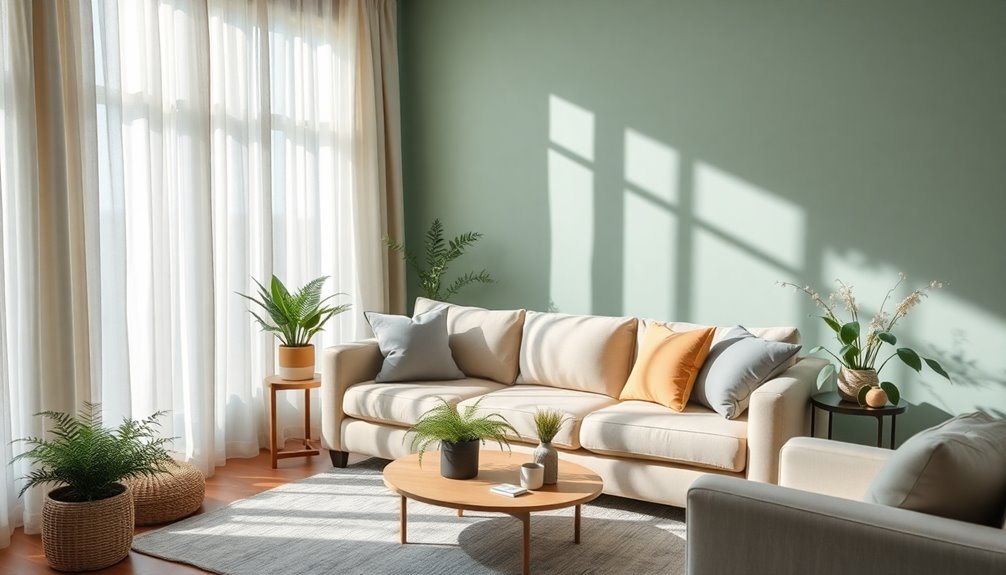
When creating a soothing atmosphere in senior living spaces, incorporating calming and nature-inspired colors is crucial. Soft blues and greens promote relaxation, making them perfect for bedrooms and lounges.
Light beiges and earthy tones connect residents to the outdoors, enhancing their sense of well-being. Studies show that cooler color palettes can lower anxiety levels, which is particularly important for those with cognitive impairments or stress.
Lighter shades reflect more light, creating an illusion of spaciousness, hence fostering comfort in smaller environments. Additionally, incorporating soft yellows can evoke warmth and optimism in common areas, encouraging social interaction and a sense of community. Incorporation of natural elements can further enhance tranquility and promote a peaceful living environment.
These emotional and psychological benefits make careful color choices essential in senior living design.
Light Reflection and Its Effects on Space Perception
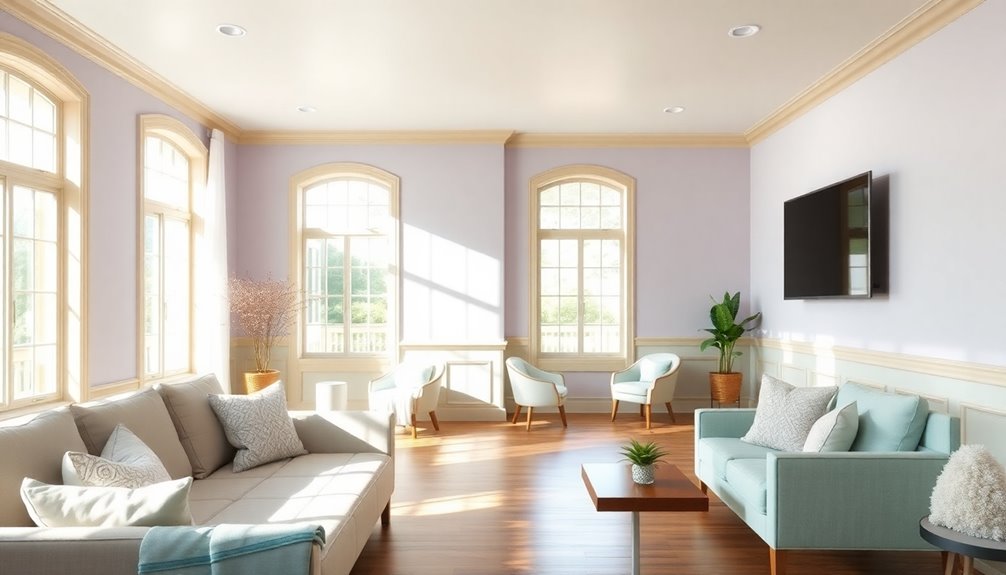
When you choose colors for a senior living space, consider how light reflection affects room size and mood.
Lighter colors can open up a space, making it feel larger and more inviting, while darker shades may create a cozy but potentially confining atmosphere.
Impact on Room Size
Color can considerably affect how spacious a room feels, especially in senior living spaces. By making thoughtful color choices, you can enhance the overall well-being of residents.
Here are three key benefits of using light colors:
- Illusion of Space: Light colors like soft whites and pale yellows reflect more light, making rooms feel larger and more open.
- Enhanced Comfort: Soft pastels evoke tranquility, creating a sense of comfort that fosters relaxation.
- Brighter Environment: Light-reflective surfaces increase natural light, promoting a serene atmosphere.
In contrast, darker colors absorb light, making spaces feel confined. Additionally, the use of natural hues in decor can seamlessly blend indoor spaces with the surrounding landscape, enhancing the overall calmness of the environment. Furthermore, incorporating elements of universal design in home decor allows for a more inclusive and functional space, catering to individuals of all ages and abilities. By prioritizing accessibility alongside aesthetic appeal, homeowners can create an environment that feels both welcoming and practical. This thoughtful approach not only improves the usability of a home but also fosters a sense of harmony between the interior and exterior, contributing to a more serene atmosphere.
Brightness and Mood Enhancement
Light colors not only create the illusion of spaciousness but also greatly enhance mood and well-being in senior living spaces.
By choosing bright, soft hues like pale blues and greens, you can foster a calming atmosphere that supports emotional stability. These light colors reflect natural light, increasing brightness and reducing visual strain, which is essential for seniors maneuvering their surroundings.
The inviting nature of lighter shades promotes cheerful environments, directly influencing residents' satisfaction. Incorporating light-reflective finishes in paint can further enhance this effect, ensuring the space isn't only more open but also uplifting. Additionally, integrating energy-efficient designs can contribute to a more sustainable and comfortable living environment for seniors.
Ultimately, prioritizing brightness and mood enhancement through color choices greatly contributes to the overall well-being of seniors.
The Importance of Low-VOC and Odorless Paints
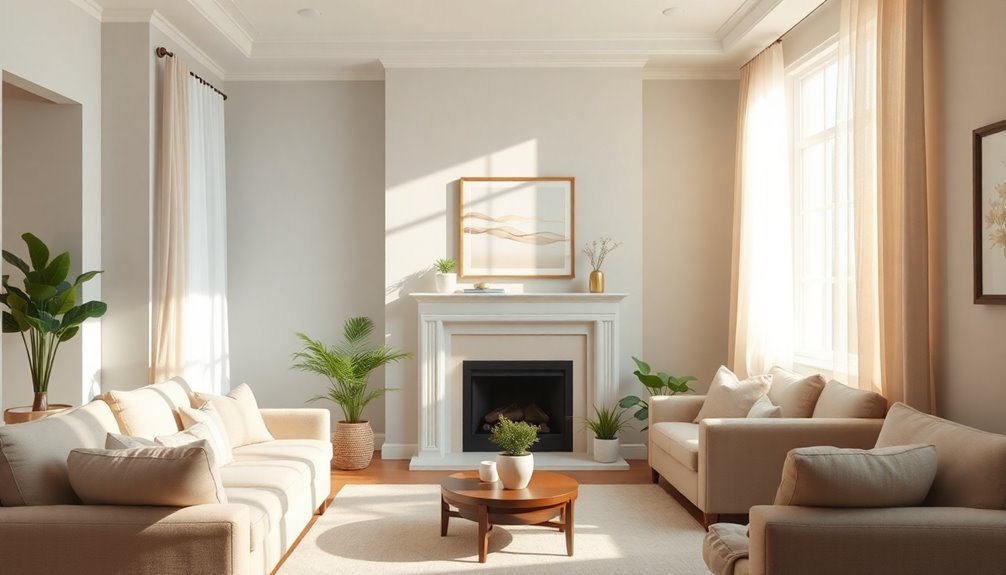
- Respiratory Health: Low-VOC paints release fewer harmful chemicals, promoting a healthier living environment for residents with respiratory sensitivities.
- Comfort: Odorless paints guarantee that seniors can enjoy their spaces without discomfort from strong paint smells during application.
- Durability: Many low-VOC options maintain durability and washability, making them ideal for high-traffic areas while easing maintenance concerns. Additionally, maintaining a clean environment helps reduce allergens and pollutants, further enhancing the well-being of seniors.
Enhancing Wayfinding Through Color
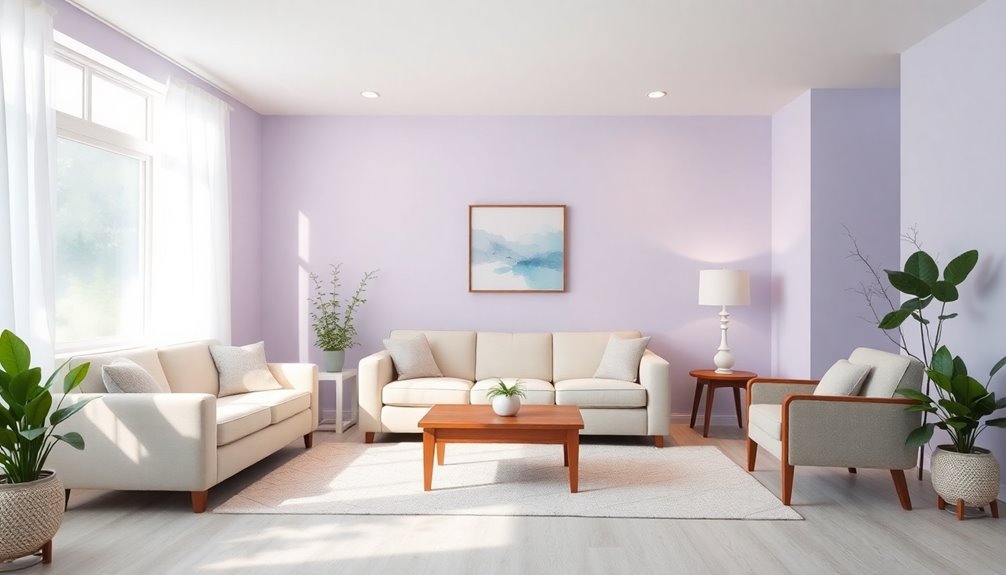
Creating a healthy environment with low-VOC and odorless paints sets the stage for improving wayfinding in senior living spaces.
Thoughtful color selection can greatly enhance navigation, especially for residents with cognitive impairments. By using distinct color schemes for different areas, you provide clear visual cues that help residents identify pathways and communal spaces.
Soft, contrasting colors can create a calming atmosphere, fostering a sense of independence. Warm colors like soft yellows inspire optimism, while cool tones like blues and greens promote relaxation.
Additionally, incorporating personal preferences in color choices, reflective of residents' cultural backgrounds, can improve their emotional responses and further assist in wayfinding.
This personalized approach not only aids navigation but also enriches their overall living experience.
Creating Cohesive Color Schemes in Living Spaces
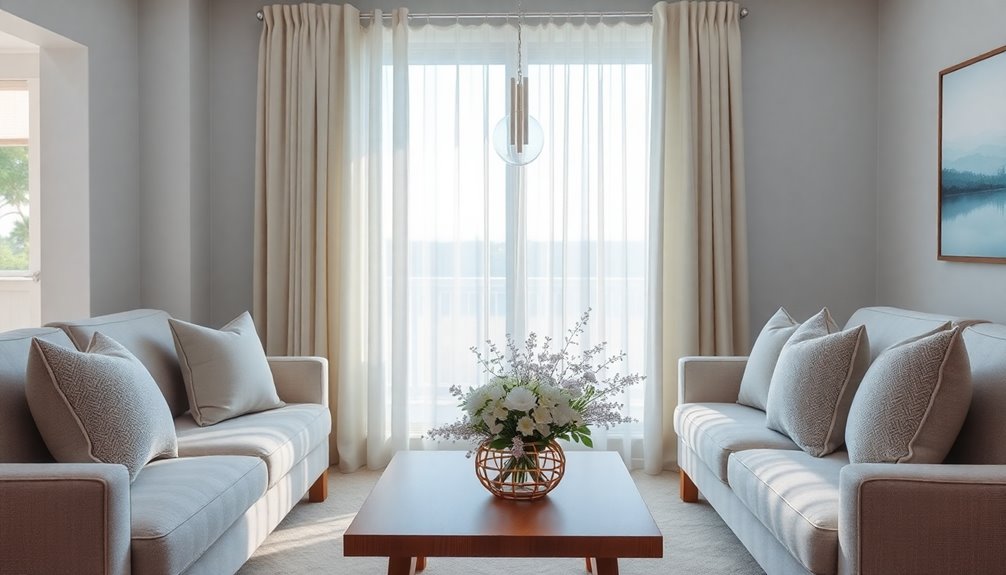
When designing senior living spaces, a cohesive color scheme not only enhances aesthetic appeal but also supports residents' emotional well-being.
To create a serene environment that promotes calmness, consider these key elements:
- Nature-Inspired Colors: Use soft blues, greens, and warm earth tones to connect residents with the natural world.
- Varying Shades: Establish a palette with different shades of the same color to create visual harmony and comfort.
- Accent Colors: Incorporate accent colors sparingly in common areas to stimulate social interaction without disrupting the overall calmness. Additionally, consider integrating smart home devices that can be controlled by a cohesive color scheme to enhance both safety and serenity for residents.
The Benefits of Professional Painting Services
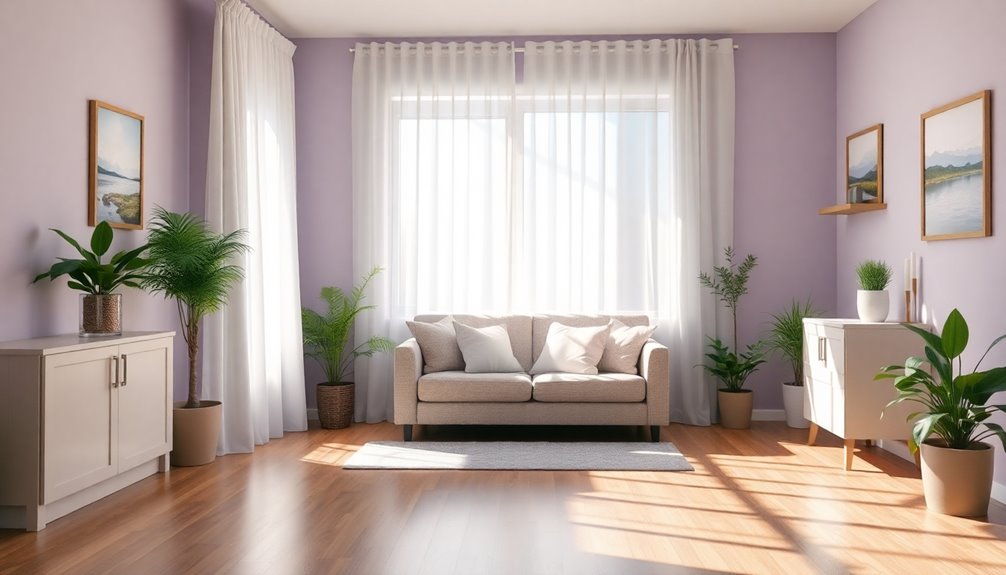
When you choose professional painting services, you gain access to their expertise in selecting colors that enhance mood and well-being.
They tailor solutions to meet the unique needs of your living spaces while ensuring safety and durability with high-quality materials.
This way, you create a comfortable and visually appealing environment for the seniors in your care.
Expertise in Color Selection
While you might think selecting colors for senior living spaces is simply a matter of personal preference, professional painters bring invaluable expertise to the table. Their knowledge can profoundly impact the well-being of residents.
Here's how they help:
- Understanding Color Psychology: They apply principles of color psychology to promote relaxation and comfort.
- Creating Cohesive Spaces: They guide communities in creating harmonious environments that reflect tranquility.
- Safety and Practicality: They select durable, low-VOC paints that enhance safety and maintain a pleasant appearance.
Additionally, their experience with energy monitoring features allows them to suggest color schemes that can help improve lighting conditions and reduce energy consumption in these spaces.
With their expertise in color selection, professional painters guarantee that the chosen palettes not only create spaces of calm and serenity but also cater to the emotional needs of seniors, enhancing their overall quality of life.
Tailored Living Space Solutions
Choosing the right colors for senior living spaces isn't just about aesthetics; it can greatly enhance residents' quality of life.
Professional painting services offer tailored living space solutions that prioritize both beauty and well-being. They understand how to select color schemes that promote serenity, using their expertise to create calming environments in senior living communities.
By providing color consultations, they consider the emotional needs of residents, ensuring peace of mind. Additionally, these professionals use high-quality, low-VOC paints that are safe and odorless, enhancing comfort.
Their knowledge of color psychology allows for strategic placement of hues, improving wayfinding and overall happiness. Incorporating elements of mental clarity and health, you can trust that your living spaces will remain fresh and inviting for years to come.
Ensuring Safety and Durability
Ensuring safety and durability in senior living spaces is essential for creating environments that residents can navigate with confidence.
Professional painting services offer several benefits:
- Durable Surfaces: High-quality, scuff-resistant paints keep walls looking clean, especially in high-traffic areas.
- Safety Features: Expert painters highlight safety features with strategic color use, catering to the unique requirements of senior living.
- Color Consultations: Professional consultations help select hues that enhance mood while complying with community regulations.
Additionally, the use of energy-efficient systems in heating and cooling can further improve the comfort and well-being of residents in these spaces.
Personalizing Color Choices for Individual Needs
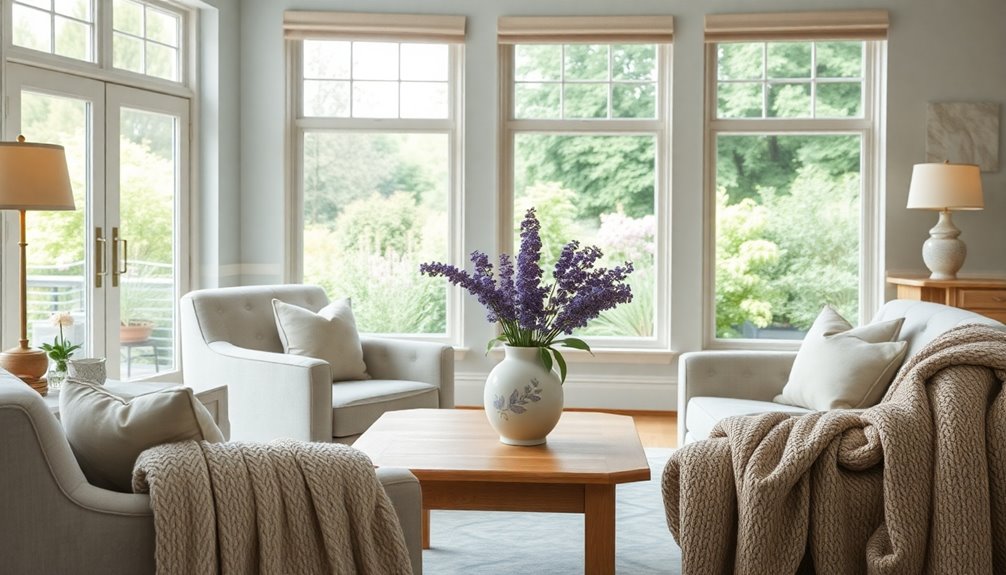
Personalizing color choices in senior living spaces can greatly boost emotional well-being, as it allows residents to express their individuality and connect with their past.
By incorporating calming colors like soft blues and greens, you can create an environment that reduces anxiety and promotes relaxation. Nature-inspired hues, such as beiges and gentle earth tones, enhance comfort and foster a serene atmosphere.
Tailoring color palettes to accommodate unique needs, like aging-related changes in color perception, guarantees visual clarity. Engaging residents in the color selection process not only resonates with their memories and cultural backgrounds but also fosters a sense of identity and belonging.
Ultimately, personalizing color choices transforms senior living spaces into comforting, personalized sanctuaries.
Frequently Asked Questions
What Color Is Calming for the Elderly?
When considering calming colors for the elderly, soft blue hues often come to mind. They promote relaxation and evoke a sense of tranquility.
Deeper green tones also connect with nature, fostering a comforting atmosphere.
Light neutrals like soft grays and beiges enhance feelings of safety, while pastel shades like pale pinks and light lavenders can reduce anxiety.
Choosing low-VOC and odorless options is essential for ensuring a safe, soothing environment for seniors.
What Are the Best Colors for Calming Living Rooms?
As the saying goes, "There's no place like home."
When you're designing a calming living room, consider soft blue hues that evoke the sky, gentle greens reminiscent of nature, and light neutrals for a spacious feel.
Lavender can soothe anxiety, while earth tones create a cozy atmosphere.
These colors not only enhance the aesthetic but also promote relaxation and comfort, making your living space a true sanctuary for unwinding.
What Color Instills Calmness and Serenity?
When you think about colors that instill calmness and serenity, soft blues and gentle greens often come to mind.
These hues can evoke feelings of tranquility and connection to nature. Light neutrals, like soft grays and beiges, also create a soothing atmosphere while making spaces feel larger.
Incorporating these calming colors into your environment can help reduce stress and anxiety, enhancing your overall emotional well-being and promoting a peaceful living experience.
What Color Would You Use to Create a Serene and Peaceful Site?
Imagine a space where vibrant chaos meets tranquil calm.
To create a serene and peaceful site, you'll want to embrace soft blue tones, reminiscent of gentle waves. Pair these with muted greens, connecting you to nature's embrace, or light pastels like pale yellow to evoke cheerfulness.
A neutral palette can enhance spaciousness and tranquility.
Conclusion
In the tapestry of senior living spaces, colors weave a story of calm and serenity. By choosing soothing hues, you're not just painting walls; you're creating a sanctuary where memories can flourish like blossoms in spring. Each shade reflects a promise of comfort and familiarity, guiding residents through their daily lives. As you personalize these spaces, remember that every brushstroke symbolizes your commitment to nurturing a peaceful environment, transforming a house into a true home.
